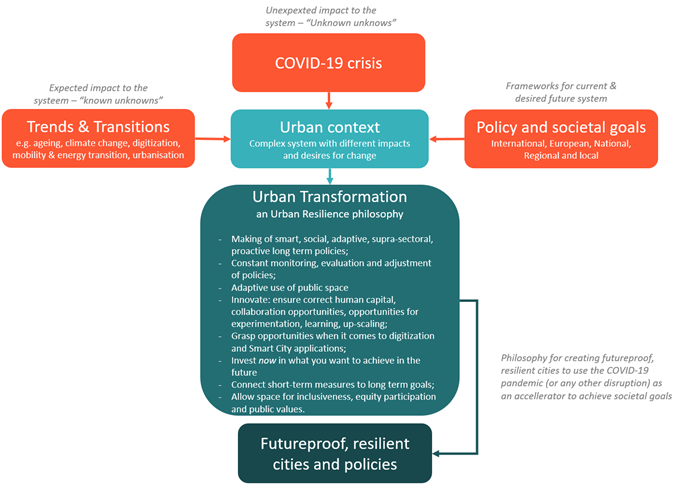How can insights learned during the COVID-19 pandemic help us to work towards resilient and futureproof cities?
Marjolein Heezen –TNO, Strategic Analysis and Policy, Strategy and Policy
Geiske Bouma – TNO, Strategic Analysis and Policy, Strategy and Policy

Figure 1: Urban Transformation philosophy in the urban context to achieve futureproof, resilient cities and policies. Sources: (Fransen & Edelenbos, 2020; Chong, 2020; Heezen & Ebbers, 2020; The Resilience Shift, 2020; ITF-OECD, 2020).
Figure 1: Urban Transformationphilosophy in the urban context to achieve futureproof, resilient cities andpolicies. Sources: (Fransen & Edelenbos, 2020; Chong, 2020; Heezen & Ebbers, 2020; The ResilienceShift, 2020; ITF-OECD, 2020).Intro
COVID-19 can be seen as a disruption to our system that not only impacts health but also our social life (isolation, working from home), the economy (job loss, economic insecurity), use of space (shift in mobility, new activity patterns, appreciation of public space and behavior change) and institutional contexts (new role for (local) government, more decisive). This disruption allowed for cities to take actions in a way they didn’t before (due to gained momentum). This can be linked to an urban transformation resilience philosophy along two lines: couple short term actions towards achieving long term goals (faster), and anchor insights and handling into policy making to allow for resilient and futureproof cities and policies.
COVID-19 in the urban context: examples from Rotterdam and Milan
The impact of COVID-19 goes way beyond just impacting health and is tangible on the streets. This urban context is a complex system where COVID-19 can be seen as an unexpected disruption. Here, also long-term trends and transitions take place, of which we know they have an impact, just not what it exactly entails – the so-called known unknowns (Van der Steen, 2016). Lastly, this context is framed by policy and societal goals. The pandemic highlights obstacles and possibilities in the urban context and thereby gives momentum for change, doing things differently. Milan and Rotterdam will be described as examples of acting upon this momentum.
Milan and its surroundings are known for having one of the highest levels of air pollution in Europe, which has an effect on the lungs of its inhabitants, thereby making the risk of dying from COVID-19 twice as high as in the rest of Italy (Gross &Hook, 2020). The lockdown caused a significant improvement in air quality and the city used the momentum to stimulate active modes by creating bike lanes, widening sidewalks and installing a speed limit of 30 km/h (Comune di Milano,2020; Deponte, Fossa & Gorrini, 2020).
The city of Rotterdam performed experiments in public space to learn for the future. For example, they used waste wood to build temporary terraces on former parking spaces and busy, car-dominated intersections were transformed into green squares designated for active modes. They also launched a real-time app to gain insight into shared mobility locations and availability in order to relieve pressure on public transport.
Urban transformation – an urban resilience philosophy
The goal for cities should not just be recovery but a drastic revision of urban development and organization by a revaluation of the urban context. The philosophy of “urban transformation”, a specification of urban resilience which focusses on the way deep-rooted patterns can be adjusted, looking further than just the pandemic (Fransen & Edelenbos, 2020). In figure 1, this philosophy is depicted within the urban context as a means to achieve resilient, futureproof cities and policy.
Conclusion
The urban transformation philosophy enables cities to invest now – making use of the gained momentum – in what they want to achieve in the future. This requires active steering on making smart, social, adaptive, supra-sectoral and proactive long-term policy with monitoring, evaluation and pivoting as part of the approach. Also, room for innovation, experimentation and learning (with consent for inclusivity, equity, participation and public values) should never be forgotten.
Additional questions:
- How to make sure lessons learned will be anchored into policy?
- Which short-term actions will help cities grow beyond recovery and towards achieving long-term goals?
- How to ensure we keep the successful measures in the long-term, even though measures were installed temporarily?
Resources:
Chong, B.(2020). Five city resilience lessons from the coronavirus. Opgehaald van ARUP.com:https://www.arup.com/perspectives/five-city-resilience-lessons-from-coronavirus
Comune di Milano. (2020). Milan 2020 adaptation strategy: Open Streets. Milaan: Comune di Milano.
Deponte,D., Fossa, G., & Gorrini, A. (2020). Shaping space for ever-changing mobility: Covid-19 lesson learned from Milan. Tema. Journal of Land Use, Mobility and Environment, 133-149.
Fransen, J.,& Edelenbos, J. (2020). Conditions for urban resilience to COVID-19:Building back stronger (Policy brief). Rotterdam: Erasmus UniversityRotterdam .
Gross, A.,& Hook, L. (2020, April 30). Academics probe links between coronavirus andtoxic air pollution. Financial Times.
Heezen,M., & Ebbers, V. (2020). COVID-19 als aanjager van bestaande transities:een stedelijk en Europeesperspectief. Plandag, 258-269.
ITF-OECD. (2020).COVID-19 Transport Brief: Re-spacing Our Cities For Resilience. Parijs: The International Transport Forum.
The Resilience Shift. (2020). 5 must-do’s on urban resilience in a time of Covid. Opgehaald vanresilienceshift.org: https://www.resilienceshift.org/urban-resilience-covid/
Van der Steen, M.(2016). Tijdig Bestuur: Strategisch omgaan met voorspelbare verrassingen. Den Haag: Nederlandse School voor Openbaar Bestuur.